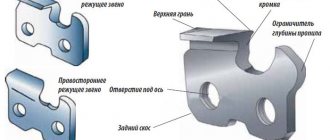What oil consumption for lubricating a chainsaw chain should be in relation to its gasoline consumption?
Chainsaws are of course different (models, power) and the oil consumption for chain lubrication is clearly stated in the instructions for a specific chainsaw.
But most often the fuel mixture tank uses a tank (tank) of chain oil.
That is, we worked out the fuel mixture, then new filling, including chain oil.
Let’s say (the volume of the tank for the fuel mixture in different chainsaws is different) a saw with a tank (fuel mixture) of 0.4 liters, the consumption of chain oil is 200 grams, that is, 0.2 liters for this volume of the fuel mixture.
Of course, many people are surprised by this consumption (when buying a chainsaw, users simply do not assume that the consumption of chain oil is so huge), to lubricate the chain you need this
It is not cheap, so there are only 2 options here, or reduce the consumption of chain oil by adjusting, of course this is a violation of the manufacturer’s recommendations, but the consumption of a tank of oil (chain) for two tanks of fuel is a completely workable option.
Or fill the chain lubrication reservoir with another less expensive oil.
Some even use waste oil, albeit purified, or automobile oil or transmission oil.
A chainsaw is, of course, more mobile (it can work far from a source of electricity) and more powerful than an electric chain saw, but if all the work is done near the house, then an electric saw is much cheaper to operate (electric saws can also have different powers).
Oil is used to lubricate the chain, but there is no fuel mixture (oil + gasoline), which is also not cheap.
Source
Learning to dilute gasoline with oil for a trimmer if you underfill or overfill the oil
If you have bought a trimmer, brush cutter, brush cutter, chainsaw and other types of equipment, then you probably know that they use two-stroke engines as power units. These engines do not run on pure gasoline, like four-stroke engines, but on a mixture of gasoline and oil. In what proportion should gasoline be diluted with oil for a trimmer? This is a question every summer resident asks himself before preparing the tool for work. We will look into this issue in detail, since diluting gasoline with trimmer oil affects the service life of the tool, and improper preparation of the mixture will lead to rapid engine wear. What is dangerous about excess or insufficient amount of oil in gasoline for a trimmer:
- If gasoline is diluted with a large amount of oil (above normal), this will not only lead to a large amount of smoke, but also to the formation of carbon deposits on the cylinder walls and a drop in power.
This carbon deposit will cause piston wear, which will be diagnosed by a decrease in its performance. - If gasoline contains insufficient oil, poured into the trimmer, then this is even more dangerous.
After all, the working mechanisms of the engine will not be lubricated in sufficient quantities, which will ultimately lead to their rapid wear (the piston rings are quickly destroyed and the engine jams). If there is insufficient amount of oil in gasoline poured into the trimmer, engine wear will occur tens of times faster.
To avoid having to pay for mistakes by overhauling the engine or purchasing a new tool, it is necessary to fill the tank with the correct consistency of fuel from the first day. You can find out the ratio in the instructions for the tool, since models from different manufacturers may give different recommendations. Typically this ratio is as follows:
- 1 to 25 or per 1 liter of gasoline 40 grams of two-stroke oil
- 1 to 40 or per 1 liter of gasoline 25-30 grams of lubricant
- 1 to 50 - this is 20 grams of oil added per liter of gasoline
The standard value is 1 to 50 (indicated on cans of oil for two-stroke engines), but it is necessary to rely on it as a last resort, since manufacturers indicate the recommended proportion value, and if it is not followed, the service life of the two-stroke engine is reduced.
In addition to maintaining the proportions, you also need to learn how to prepare the mixture. After all, the option of adding oil to the gas tank is strictly contraindicated, although some do it. If you bought a trimmer or lawn mower, you will need consumables that you will use to prepare the mixture. The instructions for preparing the fuel mixture in the trimmer are as follows:
Prepare gasoline and two-stroke oil, based on the above recommendations for choosing a lubricant and fuel. Additionally, to prepare the mixture, you need to take a container or container. Usually a plastic bottle is used for this, the selection of which requires an appropriate approach. It should be clean inside. It is not recommended to use milk containers for beer and other drinks.
The best option is a mineral water container. It is very important that the container has a whole volume value, that is, 1 or 2 liters, so that you do not have to calculate how much oil to pour into a 1.5 liter, 1.3 or 1.25 liter bottle liter because you can easily make a mistake. You will also need a syringe, which is used as a measuring device for dosing oil. For such purposes, a regular medical syringe with a capacity of 10 or more cubic meters is suitable. It is advisable that the syringe have an accurate measuring scale. After preparing the necessary materials, you can start preparing
It is advisable that the syringe have an accurate measuring scale. After preparing the necessary materials, you can start preparing
Instructions for preparing the fuel mixture in a lawn mower:
- First you need to fill the plastic container. The container is filled 2 fingers full, not enough to hold the oil.
- The required amount of two-stroke oil is drawn into the syringe and poured into a bottle with the collected gasoline. This is exactly what you need to do, not the other way around.
- After adding lubricant to the bottle, you need to close it tightly with a lid and stir. However, keep in mind that oils marked “pre mix” need to be stirred. If the oil container is marked “self mix”, then there is no need to shake the container, and after combining the substances, you can pour them into the tool tank
After preparing the fuel mixture for the trimmer, all that remains is to refuel the tool and get to work. Let’s take a closer look at how to properly refuel trimmers, lawn mowers, chainsaws and other types of motorized equipment.
This is interesting!
For dilution and use in the trimmer, only fresh gasoline is used.
Chainsaw chain lubrication oil. Review, lubrication process, reviews
A chainsaw is a rather complex device that requires constant care and maintenance. The owner of the tool can perform some of this work independently; if complex malfunctions occur, we recommend contacting experienced mechanics.
The performance of a chain saw and electric saw depends on many circumstances. The power of the motor, the experience of the operator, the quality of the saw set and fuels and lubricants should be taken into account. In addition, modern chainsaws are equipped with automatic chain lubrication, without which it is now difficult to imagine even the cheapest tool.
We will tell you in our material what the automatic chain lubrication system is, how it functions and what its serviceability depends on. We will pay special attention to the problem of choosing lubricating oil and introduce you to the recommendations of leading manufacturers in this matter.
General characteristics of Huskvara chainsaws
| Power indicators | 3900 W |
| Working volume | 70.7 cu. cm |
| Rotation speed per minute | 9600 rpm |
| Idle speed | 2700 rpm |
| Maximum possible torque | 4.3 Nm |
| Cylinder diameter | 5 cm |
| Cylinder stroke | 36 mm |
| Fuel tank volume | 0.77 l |
| Oil tank volume | 0.4 l |
| Chain pitch | 3/8 inch |
| Groove width | 1.5 mm |
| Tire length | 38-70 cm |
| Number of cutting unit links | 68 pieces |
| Chain speed at maximum power possible | 21.4 m/s |
| Weight of the Husqvarna 372 XP chainsaw without cutting mechanism | 6.1 kg |
| Oil pump flow | From 4 to 20 ml per minute |
| Operator sound level | 103 dB |
| Vibration level produced | 3.5-4 m/s2 |
| Tool dimensions (LxWxH) | 480x265x345 mm |
| Manufacturer's warranty | 12 months |
The structure of the chainsaw and where to fill the oil
Now we will “plunge” into the very core of this tool, so that you can at least have a general idea of what your “assistant” consists of, in order to be able to determine the malfunction of a particular part in case of problems with the chainsaw. In fact, this kind of tool can be responsibly attributed to classical mechanisms that operate by activating an internal combustion engine.
Without exaggeration, we can say that this type of tool is the simplest of all other mechanisms, since the saw does not have a gearbox and is equipped with a conventional two-stroke engine, which has one cylinder and runs on gasoline. The main advantage of a chainsaw is that it is designed quite simply, which helps to increase reliability, as well as trouble-free operation in difficult and difficult conditions. Next, let's look at the design of the saw in more detail, so:
- engine;
- clutch;
- ignition system;
- carburetor (see carburetor setting);
- fuel system (see ratio of gasoline and oil);
- air purification system;
- starter;
- chain (see how to sharpen a chain with your own hands);
- tire;
- chain brake;
- chain tension mechanism;
- chain lubrication system.
In essence, we have sorted out the device, but now an important issue remains the lubrication of the chainsaw parts. Many people do not understand why it is needed at all? The answer is quite simple, like all mechanisms, a chainsaw, especially its individual parts, require special care, including periodic lubrication.
This is necessary in order for your tool to serve you for many years , since during operation, the chainsaw spare parts produce a movement that must be smooth, smooth, so as not to damage nearby spare parts.
Just as everyone knows that the friction force disrupts the surface, so here, if you do not lubricate the chainsaw as necessary, the spare parts will simply wear out quickly and the tool will fall out of tune. You need it? Don't think. Therefore, it is necessary to take care of your chainsaw so that it “has the strength” to serve you for many years.
Operating principle of a two-stroke engine
Two-stroke engines operate in a slightly different way. In these engines, just like in four-stroke engines, there is a crankshaft, a connecting rod and a piston that runs inside the cylinder. Then the differences begin. Let's look at them step by step.
principle of operation of a two-stroke engine
The first and most important difference is the gas distribution system.
There are no usual camshafts, valves or cylinder head as such. This function is performed by the so-called windows (exhaust, intake and purge) and the chamber in the engine crankcase.
There is no oil in the engine crankcase. Absolutely not. Motor oil for two-stroke engines is stored in a separate tank or mixed with fuel. There is oil only in the gearbox, which is often combined with a two-stroke engine.
Instead, the crankcase has a sealed chamber. When the piston goes up, a vacuum is created in this chamber. Through the inlet window, the fuel-air mixture is sucked into this cavity from the power system.
Two-stroke engine piston with long smooth skirt
There are windows on the cylinder walls: outlet and purge. They are closed by the piston body. When the piston goes down after combustion of the mixture under pressure, shortly before the bottom dead center it opens the exhaust window. The exhaust gases partially escape, and the pressure in the chamber normalizes. A purge window is located just below.
The piston, moving down the cylinder, creates pressure in the crankcase chamber, where the fuel-air mixture drawn in earlier during the stroke is already located. And when it reaches the purge window, the mixture, under the influence of pressure, squeezes out the remaining exhaust gases from the cylinder and fills the combustion chamber.
The piston goes up and closes both windows. At top dead center, the spark plug ignites the air-fuel mixture. The cycle begins again.
Another significant difference is the absence of oil scraper rings (compression rings only) and needle bearings instead of liners in the connections of the connecting rod with the crankshaft and piston. There is also often no liquid cooling system. The motor is cooled by the passing air flow.
Another visual diagram of the operation of a two-stroke engine
The advantages of two-stroke engines include:
- Good power density ratio (relatively high power per unit weight).
- Ease of manufacture.
- Easy to maintain.
Significant disadvantages include:
- Relatively short resource and low reliability.
- Relatively low efficiency.
- High probability of overheating (for two-stroke air-cooled internal combustion engines).
Air-cooled two-stroke engine oil is added to the fuel. This feature imposes some restrictions on its properties. But we'll talk about this later.
The ratio of oil and gasoline for a chainsaw
To find out how much oil to pour into gasoline for a chainsaw (as for any other two-stroke equipment: trimmer, motor drill, etc.), you need to look at the correct proportion in the instructions for the saw or on the packaging. Typically, when using the “native” version, the proportion is 1:50. If another type is used, it is recommended to mix it in a ratio of 1:40. That is, for example, with a proportion of 1:50, divide 1 liter by 50 and get 0.02 liters - this is the amount that needs to be added to 1 liter of gasoline. That is, pour 20 ml per 1 liter of gasoline.
How to properly prepare a gasoline-oil mixture for a chainsaw during break-in
As has already been said, during the process of running in a chainsaw, grinding in of parts occurs.
To increase the quality of grinding in parts, it is recommended to fill the tank with gasoline with an increased amount of oil than recommended by the manufacturer. Why is this necessary? During lapping, an increase in friction is observed, so the parts heat up more. To reduce the heating temperature, the friction coefficient should be reduced, which is possible by preparing gasoline with an increased amount of oil. The gasoline used is AI-92 grade, and you should not use fuel with a higher octane number, as this will only harm the instrument. The buyer must only be sure that the gasoline being poured is of really high quality and corresponds to the declared resistance to ignition under compression.
Oil for preparing the fuel mixture should be used only and exclusively two-stroke. How much oil should be added to 1 liter of gasoline during break-in? To do this, refer to the instructions supplied with the tool, where the manufacturer indicates the normalized value. As a rule, this indicator corresponds to a value of 1 in 50 or 1 in 40. Less common norms are 1 in 30 and 1 in 25, and often such values are presented for Chinese chainsaws. Now let's find out how to properly prepare the gasoline-oil mixture when running in a chainsaw? When grinding in instrument parts, you need to rely on the manufacturer’s recommended proportion value with an addition of 20% or 5-10 ml.
- If the manufacturer recommends diluting gasoline with oil in a ratio of 1 to 40, which corresponds to 1 liter per 25 ml. In this case, you need to add another 5-10 ml to 25 ml of oil. This proportion is appropriate only for the period of running in the tool, which allows reducing overheating of the CPG. However, there is no need to be zealous, since carbon deposits cannot be ruled out on the walls of the CPG.
- When running-in is carried out in winter, then at least 10 ml of oil is added to the norm, and if in summer, then it is enough to add 5 ml to the normal proportion. Increasing the proportion of gasoline and oil in winter must be done in order to prevent excessive viscosity of the lubricant at low temperatures, which will lead to poor quality lubrication of parts.
- It is recommended to use only 2T synthetic oils intended for internal combustion engines with an air cooling system. Synthetic oils are more expensive than mineral oils, but they help increase the service life of the CPG of your tool.
It is not recommended to store the finished mixture for more than 2 weeks if alcohol is present in the composition. If you are sure that gasoline is not diluted with alcohol, then the storage period increases to 2-3 months. Knowing how much oil needs to be added to gasoline when running in a chainsaw, you can safely prepare the mixture and begin the procedure.
Interesting to know! If you are running in chainsaws of the Druzhba or Ural brand, then when running in the engine you need to adhere to the proportion of 1 to 15, that is, you need to add 66 ml of oil per 1 liter. After grinding in the parts is completed, add 50 ml of oil per 1 liter of gasoline.
Chain oil
In other cases, it is quite possible to replace the chain lubrication oil with any other oil other than working oil. However, there is one more nuance... Users often have a question: “Why is the oil consumption for chain lubrication greater than the fuel mixture? After all, their consumption is related to each other? Here it is worth considering that chainsaw manufacturers calculate the oil consumption for lubricating the chain when filling in their branded oil. And the consumption of any other may differ either less or more.
On many chainsaws, starting from semi-professional ones, it is possible to adjust the oil flow rate for chain lubrication. This is done by adjusting the performance of the oil pump.
If such adjustment is not provided, then the settings come initially from the manufacturer. How to check whether the oil consumption for lubricating the chain on your chainsaw is normal? It is necessary to start the saw, give it gas and bring it to a board, log or other surface that is horizontal. A running chain should scatter oil particles to lubricate the chain and leave a thin, even oil trail.
When to use special chain oil
The use of special oils for chain lubrication will be justified in the following cases:
- You have a new chainsaw under warranty and to preserve it you must use oils recommended by the chainsaw manufacturer. Otherwise, if, for example, the oil pump fails, the repair will not be carried out under warranty. This is especially true for expensive professional chainsaws.
- You respect the environment and prefer not to pollute it again. In this case, oils with the prefix “bio” are suitable.
- When working at critical temperatures.
Let's look at several types of oils from different manufacturers and sort them by price category, environmental friendliness and container volume.
Brands of oils for lubricating chainsaw chains
- Chain lubrication oil Nanotek Standard. Suitable for working at temperatures down to -20 degrees.
- Adhesive oil Nanotek Premium. For operation at -30 degrees.
- Chain lubrication oil from a well-known manufacturer of machines and equipment - Enkor. Capacity 1 liter.
- And the last oil in this category is from Champion. Capacity 1 liter.
Mineral oils with the prefix “Bio”
- Makita Biotop oil.
- Husqvarna Bio adhesive oil.
- Stihl Bio Plus oil.
Branded oils intended for use according to the manufacturer's recommendations.
- Makita oil
- Makita Biotop oil.
- Husqvarna Bio adhesive oil.
- Oregon chain lubricant 1 liter.
- Stihl Bio Plus oil.
- Stihl oil 1 liter
Oils packaged in large containers allow you to save on purchases. Relevant for enterprises with a large volume of work.
Often the most optimal choice of oil for lubricating the chain and bar will be the simplest oil of the M-8 or M-10 brand. Its characteristics fully satisfy the necessary purposes.
At low temperatures, it is necessary to pour oil with a low thickening point , otherwise the oil supply pump may fail.
Main brands of motor oils for chainsaws
The leaders in the production of high-quality lubricants for chainsaws and brush cutters are the companies Shtil and Husqvarna. Their range includes both conventional mineral lubricants for two-stroke engines and synthetic oils for severe operating conditions. Let's take a closer look at the range.
STIHL HP
STIHL HP mineral lubricant was specially developed by STIHL engineers for use in their tools. That is why owners of Shtil chainsaws and lawn mowers are recommended to use this type of oil.
Its color is red, shelf life in a closed container is no more than four years. It is packaged in several types of containers, so you can choose the most convenient packaging for yourself. Not so long ago, convenient containers of 20 grams appeared, which are diluted with one liter of gasoline. For those who rarely use a chainsaw, this is the best option. Can be diluted and used immediately.
STIHL HP fully complies with high European standards.
HP Ultra
Another oil from Stihl. It has a synthetic base, due to which it has improved combustion characteristics, cleanliness and engine protection.
Recommended by the manufacturer for long-term use in harsh conditions. Ideal for working at low temperatures. HP Ultra does not harm the environment, since oil spilled on the ground decomposes by 80% in just 21 days.
Packaged in two types of containers, 100 ml and liter bottles. The proportion of the finished fuel mixture is 1:50, which means a 100 mm bottle is enough to prepare 5 liters of the mixture. Green color. Shelf life 4 years.
The cost of this oil is significantly higher than the cost of STIHL HP, so it is not profitable to use it constantly.
It is worth noting that Stihl oils, before going on sale, go through the company’s laboratory, where they are tested to ensure they meet all requirements.
When developing oils, much attention is paid to fuel combustion, cold start characteristics, biodegradability, and viscosity change at different temperatures (information from the company’s official website)
Husqvarna HP 2-stroke
Husqvarna HP oil, like its STIHL HP counterpart, is also designed specifically for 2-stroke engines.
According to the manufacturer, this type of oil has additives that compensate for the low quality of fuel, which is important for our country. The declared octane number of gasoline at gas stations rarely corresponds to the real one.
Husqvarna HP – semi-synthetic, green. Packaged in liter or ten liter containers. The proportion of the mixture is 1: 50, i.e. 20 grams per liter. During the period of running in the saw engine or when working in cold weather, it is possible to increase the proportion to 1:40, which will give the engine greater protection and increase its service life.
Today, there are a large number of lubricants for two-stroke engines on the market from different manufacturers. For this reason, answering the question of which chainsaw oil is best is quite difficult. Our opinion is that you should trust reliable companies, which are Shtil, Husqvarna, Oregon, Champion. It is their oils that will maximize the protection of your tool’s engine and extend its service life.
Unscrupulous manufacturers often disguise their products under well-known brands (Husqvarna, Shtil, etc.). Such oils are of low quality and can harm the engine. In order not to be deceived, it is necessary to purchase lubricants from official representatives who have the necessary certificates for the products. You can learn how to distinguish a fake from an original from the video:
Which oils are suitable for chain lubrication - classification
To lubricate the chainsaw chain, it is recommended to use the following types of oils:
- from well-known global manufacturers (Stil, Daewoo, Husqvarna and others, the packaging of such oils usually has o);
- original chain ones from the manufacturer of the same name (if such are available in the range);
- with good biodegradability according to CEC-L-33-T-82 (> 95%);
- with a viscosity that meets European quality and safety standards. Example standard: viscosity index 130 DIN ISO 2909, density at +15°C - 0.89 g/cm³ DIN 51757, thickening point -25°C DIN ISO
What happens if you pour waste into a chainsaw?
If you don’t want your chainsaw to fail at the wrong moment, use only high-quality fuels and lubricants. Mixing waste with gasoline is prohibited. The reasons for this are the following factors:
- The viscosity of the material is different, so the grinding is not capable of providing effective lubrication of rubbing parts and mechanisms
- The waste contains small particles of metal and shavings, which, if they enter the tank, will cause clogging of the fuel filter and channel. If the lubricant gets into the cylinder along with small particles, they will leave their mark in the form of accelerated wear of the piston rings
- Emission of large amounts of black smoke, indicating oil burning
You cannot pour surrogate materials not only into the gasoline tank, but also into the chain lubrication tank. What happens if you use waste in the tank to lubricate the chain can be seen in the video.
Using the instructions, you can independently prepare the correct fuel mixture for the chainsaw to operate on. If the fuel mixture is diluted incorrectly, not only does the service life of the tool decrease, but its performance also decreases.
Publications on the topic
It served for a long time and did not cause problems with repairs; you need to prepare the fuel mixture correctly. Online forums are replete with questions on this topic. We interviewed experts and compiled short instructions.
To prepare the fuel mixture, use AI-92 or AI-95 gasoline. A lower octane number will not work. The gasoline must be unleaded (otherwise the engine will fail) and not old (the octane number may change over time). Do not use oil for boats or four-stroke engines.
Mix gasoline and oil in strictly defined proportions. Choose a synthetic oil for two-stroke air-cooled equipment of the API-TB or API-TC class. Don't skimp on ingredients. Ask stores for brands that are leading in quality. For example, Stihl, Husqvarna, NANOTEK, Champion, ALCO, etc.
The main issue is proportions. Excess oil will lead to carbon deposits on the pistons and spark plugs. Excess gasoline will cause scuffing on the pistons and rapid engine failure. On average, one liter of gasoline is mixed with 20-50 ml of oil. Stihl and Husqvarna, for example, recommend taking 100 ml of oil per 4 liters of gasoline. The specified proportion is optimal for chainsaws up to 1.5 kW. For chainsaws with a power of over 1.5 kW of the same brands, use a proportion of 1/50 (100 ml of oil per 5 liters of gasoline). Recommendations from Partner and Jonsered: proportion 1/33 (3.3 liters of gasoline + 100 ml of oil). Supersynthetic oil is added at a ratio of 100/1. These figures are approximate. Always use the information provided in the instructions for your specific chainsaw model. Rely less on the numbers on oil labels.
Mix what? On sale are canisters with measuring divisions and two holes - for oil and gasoline. Pour in the ingredients, screw on the lids and stir by tilting the container.
Many people use glass and plastic bottles, baby bottles and syringes. Be careful with glass and plastic to avoid static electricity. Be careful not to introduce any solid particles or drops of water into the mixture. Be sure to stir the mixture thoroughly.
Finished fuel cannot be stored for more than 25-30 days, because the oxidation process changes its composition. Engine failure caused by overexposed fuel is considered non-warranty. The amount of repairs reaches 80% of the cost of a new chainsaw. After the end of the working season, use up the remaining fuel, turn off the engine, and remove the remaining fuel mixture.
Remember, your goal is to create a mixture that will ensure smooth engine operation, complete combustion of fuel without the formation of soot, smoke or scuffing.
Two-stroke engines, despite their imperfections relative to four-stroke designs, are still widely used in many newly produced devices.
Legendary Java with 638 two-stroke engine
- Motors of this type are mainly used for:
- small motorcycles, snowmobiles, mopeds;
- lawn mowers, walk-behind tractors, portable generators, chainsaws;
- motor boats;
- other devices where small size with high power is required.
The design of this engine imposes some special features on operation. In particular, the usual lubrication system is absent on most designs of two-stroke internal combustion engines.
There are modifications where lubricant is supplied directly into the flow of the fuel-air mixture from a special device in the form of oil mist. However, the vast majority of oil for modern 2-stroke engines enters the cylinders along with the fuel.
Advantages of higher-priced oils
Branded chain oils contain useful antioxidant, anti-corrosion, stabilizing components and additives that help maintain the operating properties of the oil and increase the wear resistance of working equipment in difficult operating conditions.
The quality of branded consumables is standard. Most of these are products from leading manufacturers Shtil, Husqvarna, Echo, Daewoo and a number of others. Over the past few years, the quality of Chinese chain oils produced at state-owned enterprises has noticeably improved.
Owners of chainsaw equipment independently decide which oil to use to lubricate the chainsaw chain. In the best case, this is a consumable material adapted to the climate of the region and recommended in the operating instructions for this model.
Mandatory requirements for gasoline quality
The power units of household and professional chainsaws are very sensitive to the quality of the gasoline component of the fuel mixture. The best option is AI-92 automotive fuel.
- The octane ratings of this consumable material ensure optimal traction characteristics and the absence of detonation noise during sudden load changes.
- A flammable gasoline-oil mixture made from gasoline with a short shelf life and high-quality motor oil, prepared before refueling, is recommended for use.
- Pure gasoline can be stored in a sealed metal container for up to six months.
- The fuel mixture of gasoline and oil is not suitable for long-term storage. Within a month, irreversible changes occur in its composition, reducing the octane number and promoting the formation of gasoline-resistant tarry deposits.
How to replace the original expensive oil and is it worth it?
In situations where it is not possible to use original ones, they can be replaced with oil for car engines. Cheap automobile oils such as Autol or diesel lubricants, due to their reduced adhesive properties, are unsuitable for long-term use.
Some owners, despite the recommendations, still use analogues, preferring to change the tire and chain more often, but here everyone decides for themselves. Such oil cannot have any negative effects on the lubrication system, which means the difference is only in the quality of protection of the tire from chain friction.
Types of oils
Mineral oil is suitable for use in the warm season. This is due to the fact that it has increased viscosity. These oils can be purchased from 113 rubles/l (TNK 2T).
Synthetic oil has greater fluidity, which can also be used in winter conditions at low temperatures, that is, throughout the year. Mainly used for industrial chainsaws. This type is thermally stable and chemically stable. Their cost starts from 135 rubles/0.2 l (“Zubr-Expert”).
If the load on the tool is not very heavy, semi-synthetic oils can be used for year-round use. They contain mineral types as a base component, to which synthetic ingredients are added. The cost of these oils ranges from 185 rubles/0.946 l (Resoil Ultra 2T).
Manufacturers paint oils in different colors so that you can control how to dilute gasoline for a chainsaw.
The container capacity must be selected based on the use of the tool. With rare chainsaw use, 0.8-1 liters of volume per season is enough. In the case of daily long-term use, you need to focus on 5-liter canisters.
Basic malfunctions and repairs of the chain lubrication system
Let's look at common malfunctions and repairs of the chain lubrication system of modern chainsaws.
If the chain is not lubricated
The tank is full, but the oil does not flow to the chainsaw chain. There could be several sources of the problem here.
- Oil pump drive failure. Quite a common malfunction. On Stihl chainsaws, it is common to cut off the flange of the plastic drive gear. Or the splines are worn out. The gear does not rotate at all or rotates but does not engage the pump drive.
Uneven supply of lubricant
The chain receives too much or too little lubricant. When oil does not flow to the chain or is poured too much, it causes discomfort during operation and can damage the saw. This problem is a little less common, but also quite widespread. There may be several reasons.
- Incorrect adjustment. It is better not to touch the oil supply adjustment screw on some saws without understanding the adjustment process.
- Use of lubricants of unsuitable viscosity. The pump pumps lubricants that are too thick less readily, and they are less easily distributed by the chain along the tire. With liquid oils the opposite is true.
- Reduced tightness in the chain lubrication system. Sometimes the oil supply tube to the pump comes off or is damaged. This causes oil starvation. A similar problem manifests itself in lubricant leaks at the bottom of the chainsaw.
Overheat
Despite the abundant supply of oil to the chain, overheating or jamming is still observed. There is only one reason here - the use of a material that is absolutely unsuitable for lubrication. This can often be seen when pouring into the mining system.
Principle of operation
The main unit of the system is the pump. The principle of its operation is as follows. As engine speed increases, a gear mounted on the main shaft drives the pump shaft through a worm gear. In turn, the rotation of the shaft creates a certain pressure in the oil line, which forces the oil to move along it towards the tire.
The end of the oil channel is located at the point of contact of the tire with the tool housing, where there is a longitudinal groove into which, when installing the tire, its oil channel falls.
The groove is necessary to ensure the supply of oil to the bar, regardless of the degree of tension of the chainsaw chain. Simply put, no matter what position the tire is in at the time of operation, oil will get onto it through the groove.
Next, the lubrication process includes a chain, on the links of which, depending on the chain model, there is either a groove or a hole through which the oil is dispersed throughout the tire. As engine speed increases, the oil flow rate also increases.
Some models of chainsaws are equipped with pumps that additionally have capacity adjustment, and if necessary, the amount of oil supplied by the lubrication system can be increased or decreased.
This function is quite convenient, because it allows you to save money and not waste extra oil.
Oil supply system
In the Stihl chainsaw, oil is supplied to the chain by a special system. The patented OILOMATIC® system, found on various STIHL chainsaw models, is an exclusive feature. Such an incredible addition cannot be found in all models from other manufacturers. For this reason, more and more people are choosing Stihl saws. What is this system? This is a specially designed groove designed to direct oil to critical wear areas. This superior lubrication feature gives the customer extended chain life with a reduced tendency to stretch.
Self-selection criteria
Fuel for a stihl chainsaw or another model should be purchased exclusively taking into account common recommendations. These include:
- If fuel is used that is stored for a long period, this will negatively affect the traction characteristics of the internal combustion engine. In addition, such operation causes small detonations, as well as the appearance of carbon deposits.
- All chainsaw users should not pay attention to low-octane mixtures, as they are characterized by low quality.
- In some cases, leaded fuel can be used. It can significantly extend the life of the device.
Two-stroke oil for chainsaws and scythes
Practice shows that an attempt to save on the quality of the fuel used leads to a significant reduction in the service life of the device itself. In addition, performance characteristics drop significantly.
Chainsaw chain oil
The chainsaw has two tanks, one of which is filled with gasoline, and the other with oil for lubricating the equipment’s chain. The durability and serviceability of the chainsaw will depend on the quality and composition of the oil, as well as fuel. Often, hardware stores offer ready-made oil from chainsaw manufacturers ; it is intended for this purpose. The finished product is suitable for use at low temperatures and does not pollute the environment. The finished oil can be replaced with another, the main thing is that it is not used. Representatives of equipment manufacturers recommend buying branded oil or preparing a mixture based on the one specified in the operating instructions. If the instructions do not specifically indicate the type of oil, then you can buy two-stroke oil, which is sold in a specialized store. Two-stroke oil can be of two types:
Experts advise using synthetic oil for chainsaws, but it is always more expensive. The main advantage of this type of lubricant is that during operation of the equipment, carbon deposits do not form in the cylinder , and this extends the service life of the equipment.
If mineral oil has been used for 100 working hours, then it is better to continue to use it, since carbon deposits may have accumulated during operation. The synthetic product has the property of cleaning and will wash away the deposited layer from the cylinder walls, and this will lead to damage to the equipment.
Useful tips
It is important to keep in mind that as the engine speed increases, the rate of pumping of the lubricant also increases noticeably. That is why it is necessary to pour the oil mixture into an electric saw only when the engine is turned off.
Lubricating compounds for electric saw chains should be purchased exclusively at specialized retail outlets. Only such products are of high quality and effective. You should not purchase goods at markets or street shops. Most likely, they will sell you a fake, which will not only be useless, but will also lead to damage to the instrument.
There are a lot of oils on sale. But the best option is oil with good adhesive properties. Such products contain special additives. Thanks to the latter, the composition does not shake off or flow off the chain of the electric saw as it actively rotates. Only such a remedy will be effective and will have a beneficial effect on the condition of the instrument.
How to choose oil for an electric saw, learn from the video below.
Adjusting oil density to external temperature factors
The performance characteristics of the lubricant decrease when it is used when the ambient temperature drops to -20 degrees Celsius and below. Also, at low temperatures, the pump responsible for supplying oil does not work properly. The solution to this problem is often mixing the thickened composition with kerosene. Such an additive provides the required density of the substance, but it is still recommended to reduce the applied load. If the ambient temperature is too low, you need to monitor the effectiveness of lubrication of the main elements. This recommendation can also be attributed to the fact that the liquid in the wood begins to freeze, increasing the hardness and reducing the degree of workability. Too high a load causes rapid wear. An increase in viscosity makes engine operation more difficult. This is why many manufacturers indicate the conditions under which a chainsaw can be used.
Source
Choosing engine oil
Saw chain oil is not always used as an all-purpose option. Often, the option for the engine from which the tire receives rotation is also filled. When choosing it, the following points are taken into account:
- You should give preference exclusively to the options recommended by the saw manufacturer.
- Mineral lubricants are more popular, as they are more effective in use.
- Products from well-known manufacturers are characterized by higher performance characteristics.
- The recommended temperature regime must also be taken into account. Some versions cannot be operated at too low a temperature, as this leads to an increase in viscosity. Too high a viscosity causes structural damage when operating at high speeds.
Various brands of chainsaw oils
If you do not add lubricant to the engine in a timely manner, it can quickly wear out or even fail.
Adjusting the chainsaw carburetor
Most chainsaws have three adjustment screws on the carburetor. In order about each:
- T - Idle screw. The idle screw is responsible for the position of the throttle valve when the throttle handle is completely released. If the throttle valve is not open enough, the engine will stall when the handle is released because the throttle valve will cut off the supply of the fuel mixture. If the throttle valve is opened more than it should be, then the chain will rotate, which is strictly prohibited by safety precautions when working with a chainsaw.
- L-Low speed adjustment screw. This screw regulates the amount of fuel in the fuel mixture when the chainsaw is idling. If the amount of fuel is large, the engine will stall under load; if there is not enough fuel, the result will be engine overheating, scuffing, and so on...
- H-High speed adjustment screw. Responsible for the amount of fuel in the mixture when the chainsaw is operating. If this adjustment is set to a larger amount of fuel, then the engine runs “unacceptably” and smokes, and if it is set to a smaller amount, then we get too high speeds and overheating.
Carburetor adjustment step by step
- Check the condition of the air filter. We remove it and either clean it or change it. If the air filter is clogged with dirt and sawdust, the chainsaw will not operate normally.
- We check the condition of the muffler. It must be clean and unclogged. Read more about cleaning the muffler HERE.
- Before you start adjusting the carburetor, you should fill the fuel tank at least halfway.
- If the chainsaw is able to start, then you should let it run for a few minutes to warm up. If the adjustment is carried out “cold”, then the mixture will be over-rich after warming up.
- You need to start adjusting by adjusting the idle speed - screw L. It is highly advisable to have a tachometer, then we focus on 2700 rpm. If not, then we need to find the highest idle speed. In this case, the chain should not rotate. If it still spins (the chain, of course, and not the Earth), then we stop it by rotating screw T. The sound of the chainsaw should be the same as when listening to the file below. https://benzopilatut.ru/wp-content/uploads/2016/01/Chainsaw-at-idling.wav
- We regulate high revolutions - screw H. If we rotate it clockwise, the revolutions will increase, and if counterclockwise, they will fall. We tighten it until failures appear in the ignition. After that, turn it out about one-fifth of a turn. The sound of a chainsaw when operating at maximum speed should be like this when listening to the file below. https://benzopilatut.ru/wp-content/uploads/2016/01/Chainsaw-maximum-speed.wav
- Let's check how the chainsaw is gaining momentum. She should type them smoothly and quickly. If the speed increases slowly, then turn out screw L slightly.
How to calculate the hourly rate of fuel consumption for a Calm chainsaw
And gasoline... just off the top of my head... I’ve been using the Peshkarus for 3 years now (-)... my price has stopped at about 8-9 rubles-)....) according to your calculations -25 rubles 1 filling (40 min) or 38 rubles an hour (124/3 ,3) then the following question arises: How advisable is it to have a saw in the Moscow region... That is? How many cubes of firewood (logs) can be cut on average (without tearing) in an hour or 3.3 hours with a Husqvarna 136 saw and how much does a cube cost in the Moscow region, etc. logs….(or how much does a cube of firewood cost and how much does it cost to chop it)….In my opinion, very interesting questions (we do not yet take into account the price of the saw, and its repair and maintenance) (Of course, I will omit the pleasure of cutting firewood, for me this is a separate issue history, that’s why I want a saw...) VladlenPopolitov (Khimki) May 11, 2004 18:25:12 Regarding the price of oil - I looked at your link, it’s true.
Characteristics of oil for the mixture
Chainsaws are equipped with two-stroke engines, so the choice of oil must be appropriate. They can be of API-TA and API-TB classes, designed for them, which are air-cooled, and are capable of operating under heavy loads.
Motor oils consist of a base and additives. The latter provide the best mixing of oil and gasoline. With their help, they prevent corrosion processes, as well as the formation of deposits, which reduces the smoke output and keeps engine parts clean. You can read about the effect of additives on the packaging.
Is it possible to use 92 gasoline instead of 76 (80)?
An interesting topic, I asked why manufacturers use additives and do not immediately produce gasoline with the required POC. And here’s what I dug up: * “To obtain high-octane gasoline from oil, different technologies are used, but only one of them - catalytic reforming - allows you to immediately obtain the required octane numbers - up to 99. But this is expensive: the share of such gasoline in the total balance of high-octane fuels does not reach 50%. The rest are produced using less complex technologies such as catalytic cracking or hydrocracking: for them the octane numbers are 82–85. And the simplest and cheapest are straight-run gasolines, but their octane numbers rarely exceed 50–60 units.
This is where various octane boosters and additives come into play. They can be roughly divided into three groups. The first is based on the use of metal-containing additives - the memorable tetraethyl lead, which gave the world leaded gasoline, now banned almost everywhere. The additive was extremely cheap and terribly effective - in short, an oilman’s dream. True, vile carcinogens flew out of the engine exhaust pipe... Now it has been replaced by a much less dangerous ferrocene.
The main problem with such additives is the formation of plaque and deposits in the combustion chamber, on spark plugs, as well as in catalysts and on the working surfaces of engine control system sensors. The maximum level of ferrocene is standardized - 0.017%, but who monitors this? There are additives based on nickel and manganese, but the problems are the same...
Another group of high-octane additives works on the principle of a “mixture” increase in octane number: base gasoline is mixed with something very, very stable. Most often, monomethylaniline (MMNA) is used, whose octane number is as much as 280. These gasolines are more expensive than ferrocene gasolines, but the main obstacle to their distribution is the Euro III and Euro IV standards, which limit the level of “aromatics”.
The third, most advanced group is ethers and alcohols. In this case, everything is fine with the environment, but there are also problems. Firstly, the octane number is relatively low - about 120, so quite a lot of them are required - sometimes even more than 10%. Since esters have a significantly lower calorific value than base gasoline, the “calorie content” of the fuel decreases. Secondly, esters are aggressive towards rubber, paint, and some plastics. It was the aggressiveness of esters that required regulatory restrictions on their “mixed” gasolines. In production, “ether” ones are the cheapest, and therefore the most common.
Why does the chain fly off and break?
If the chain falls off the chainsaw or it breaks, this means that there is some kind of problem with the device; under normal conditions it should not do this. There are three reasons why a chain falls off:
- Tire problems. They lead to loosening of the tension, which can lead to the chain breaking. Most often, this problem occurs in the groove between the outer plate on the chain set housing and the inner plate on the motor housing. The casing with the tire is secured with a bolt, which can become loose during operation of the chainsaw, as a result of which the tire begins to move or vibrate. To solve this problem, you need to find and lower the chain brake, for which you need to turn the tension screw, which is located next to the tire, until it is fully tensioned.
- The chain has stretched. Sagging may indicate a malfunction of the chainsaw mechanism. During operation, the metal is deformed, which means it can become 0.5-1 cm longer. In this case, it is recommended to replace or shorten the chain.
- The drive sprocket is poorly secured. To secure it, you need to remove the engine protective cover and spark plugs, and then pull out the air filter. The spark plug itself also needs to be unscrewed, after which a special stopper is installed in its place to secure the piston. Turn the fastening disk clockwise until the piston stops in the uppermost position. A thick rope folded several times can act as a stopper. After fixing the piston, clamp the drive sprocket. Reassemble the chainsaw, installing all parts in the reverse order.
Read also: Vacuum metallization in Moscow
Most problems can be solved by repair. Only in exceptional cases will it be necessary to change it.











